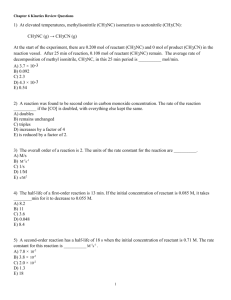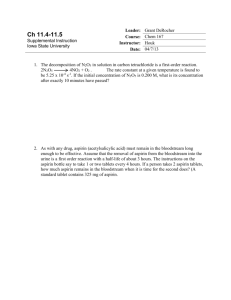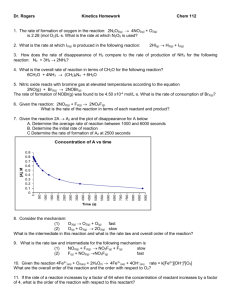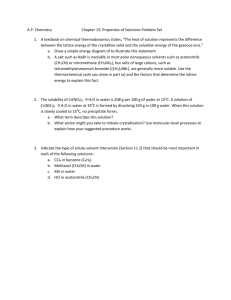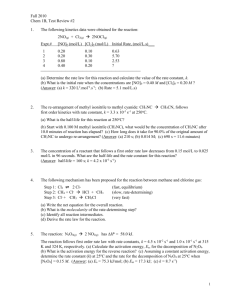www.tutor-homework.com (for tutoring, homework help, or help with
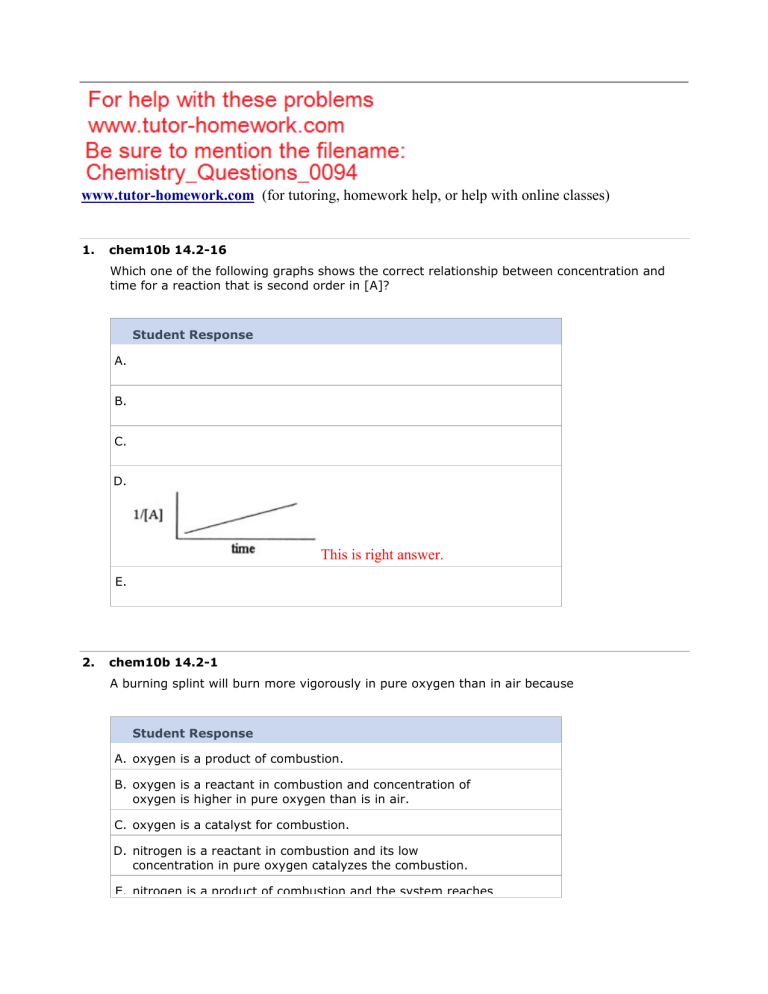
www.tutor-homework.com
(for tutoring, homework help, or help with online classes)
1. chem10b 14.2-16
Which one of the following graphs shows the correct relationship between concentration and time for a reaction that is second order in [A]?
Student Response
A.
B.
C.
D.
This is right answer.
E.
2. chem10b 14.2-1
A burning splint will burn more vigorously in pure oxygen than in air because
Student Response
A. oxygen is a product of combustion.
B. oxygen is a reactant in combustion and concentration of oxygen is higher in pure oxygen than is in air.
C. oxygen is a catalyst for combustion.
D. nitrogen is a reactant in combustion and its low concentration in pure oxygen catalyzes the combustion.
E. nitrogen is a product of combustion and the system reaches
equilibrium at a lower temperature.
3. chem10b 14.5-9
SO
2
Cl
2
decomposes in the gas phase by the reaction
SO
2
Cl
2
(g) → SO
2
(g) + Cl
2
(g)
The reaction is first order in SO
2
Cl
2
and the rate constant is 3.0 × 10 -6 s -1 at 600 K. A vessel is charged with 3.3 atm of atm. at 600 K. The partial pressure of SO
2
at is __________
Student Response
A. 3.7
B. 2.0
C. 3.0
D. 1.3
E. 2.1
4. chem10b 14.2-42
A catalyst can increase the rate of a reaction __________.
Student Response
A. by lowering the activation energy of the reverse reaction
B. by lowering the overall activation energy (E a
) of the reaction
C. by providing an alternative pathway with a lower activation energy
D. by changing the value of the frequency factor (A)
E. All of these are ways that a catalyst might act to increase the rate of reaction.
5. chem10b 14.2-5
Of the units below, __________ are appropriate for a first-order reaction rate constant.
Student Response
A. M -1 s -1
B. M s -1
C. mol/L
D. L mol -1 s -1
E. s -1
6. chem10b 14.4-9
Heterogeneous catalysts have different phases from reactants.
Student Response
7. chem10b 14.2-36
The overall reactions and rate laws for several reactions are given below. Of these, only
__________ could represent an elementary step.
Student Response
A. A + 2B → P rate = k[A] 2
B. A + B → P rate = k[A][B]
C. 2A → P rate = k[A]
D. A + 2B → P rate = k[A][B]
E. A + B + C → P rate = k[A][C]
Score: 1/1
8. chem10b 14.2-19
The reaction A → B is first order in [A]. Consider the following data.
The half-life of this reaction is __________ s.
tudent Response
A. 4.9
B. 0.97
C. 7.1
D. 3.0
E. 0.14
9. chem10b 14.1-18
At elevated temperatures, methylisonitrile (CH
3
NC) isomerizes to acetonitrile (CH
3
CN):
CH
3
NC (g) → CH
3
CN (g)
At the start of an experiment, there are 0.200 mol of reactant and 0 mol of product in the reaction vessel. After 25 min, 0.108 mol of reactant (CH mol of product (CH
3
CN) in the reaction vessel.
3
NC) remain. There are __________
Student esponse
A. 0.540
B. 0.200
C. 0.308
D. 0.092
E. 0.022
Score: 1/1
10. chem10b 14.1-3
Which substance in the reaction below either appears or disappears the fastest?
4NH
3
+ 7O
2
→ 4NO
2
+ 6H
2
O
S udent Response
A. NH
3
B. NO
2
C. H
2
O
D. O
2
E. The rates of appearance/disappearance are the same for all of these.
11. chem10b 14.1-11
The peroxydisulfate ion (S
2 reaction:
O
8
2) reacts with the iodide ion in aqueous solution via the
S
2
O
8
2 (aq) + 3I -
→ 2SO
4
(aq) + I3 - (aq)
An aqueous solution containing 0.050 M of S
2
O progress of the reaction followed by measuring
8
2 i on and 0.072 M of I -
[I is prepared, and the
]. The data obtained is given in the table below.
The average rate of disappearance of I between 400 s and 800 s is __________ M/s.
Student Response
A. 5.8 × 10 -5
B. 2.6 × 10 -4
C. 2.8 × 10 -5
D. 3.6 × 10 4
E. 1.4 × 10 -5
12. chem10b 14.2-44
__________ are used in automotive catalytic converters.
Student Response
A. Heterogeneous catalysts
B. Homogeneous catalysts
C. Enzymes
D. Nonmetal oxides
E. Noble gases
1. chem10b 14.1-9
A flask is charged with 0.124 mol of A and allowed to react to form B according to the reaction A(g) → B(g).
The following data are obtained for [A] as the reaction proceeds:
How many moles of B are present at 10 s?
Student Response
A. 0.110
B. 1.4 × 10 -3
C. 0.220
D. 0.014
E. 0.011
2. chem10b 14.2-37
For the elementary reaction
NO
3
+ CO → NO
2
+ CO
2 the molecularity of the reaction is __________, and the rate law is
Student Response
A. 2, k[NO
2
][CO
2
]
B. 4, k[NO
3
][CO][NO
2
][CO
2
]
C. 2, k[NO
3
][CO]
D. 2, k[NO
3
][CO]/[NO
2
][CO
2
]
E. 4, k[NO
2
][CO
2
]/[NO
3
][CO]
3. chem10b 14.2-45
The enzyme nitrogenase converts __________ into __________.
Student Response
A. nitrogen oxides, N
2
and O
2
B. CO and unburned hydrocarbons, H
2
O and CO
2
C. nitrogen, ammonia
D. ammonia, urea
E. nitroglycerine, nitric acid, and glycerine
4. chem10b 14.1-35
The rate constant for a second-order reaction is 0.13 M -1 s -1 . If the initial concentration of reactant is 0.26 M it takes __________ s for the concentration to decrease to
Student Response
A. 0.017
B. 1.0
C. 0.50
D. 30
E. 4.4 × 10 -3
Score: 1/1
5. chem10b 14.1-19
At elevated temperatures, methylisonitrile (CH
3
NC) isomerizes to acetonitrile (CH
3
CN):
CH
3
NC (g) → CH
3
CN (g)
At the start of the experiment, there are 0.200 mol of reactant (CH
3
(CH
3 remain. The average rate of decomposition of methyl isonitrile, CH
3
NC, in this 25 min period is __________ mol/min.
NC) and 0 mol of product
CN) in the reaction vessel. After 25 min of reaction, 0.108 mol of reactant (CH
3
NC)
Student Response
A. 0.092
B. 4.3 × 10 -3
C. 0.54
D. 2.3
E. 3.7 × 10 -3
Score: 0/1
6. chem10b 14.2-2
Of the following, all are valid units for a reaction rate except __________.
Student Response
A. mol/hr
B. M/s
C. mol/L-hr
D. mol/L
E. g/s
Score: 1/1
7. chem10b 14.2-36
The overall reactions and rate laws for several reactions are given below. Of these, only
__________ could represent an elementary step.
Student Response
A. A + 2B → P rate = k[A] 2
B. A + B + C → P rate = k[A][C]
C. 2A → P rate = k[A]
D. A + B → P rate = k[A][B]
E. A + 2B → P rate = k[A][B]
Score: 1/1
8. chem10b 14.2-26
At elevated temperatures, nitrogen dioxide decomposes to nitrogen oxide and oxygen:
NO
2
(g) → NO (g) + ½ O (g)
The reaction is second order in NO initial [NO
2
2
with a rate constant of 0.543 M -1 s-1 at 300 C. If the
2
] is 0.26 M it will take __________ s for the concentration to drop to 0.100 M.
Student Response
A. 0.299
B. 11.3
C. -0.611
D. 3.34
E. 8.8 × 10 -2
Score: 1/1
9. chem10b 14.5-8
The decomposition of N
2
O
5
in solution in carbon tetrachloride proceeds via the reaction
2N
2
O
5
(soln) → 4NO
2
(soln) + O
2
(soln)
The reaction is first order and has a rate constant of 4.82 × 10 -3 s -1 at 64°C. If the reaction is initiated with 0.058 mol in a 1.00-L vessel, how many moles remain after 151 s?
Student Response
A. 0.028
B. 0.060
C. 2.0 × 10 3
D. 0.055
E. 12
Score: 1/1
10. chem10b 14.2-38
The first step of a mechanism involving the reactant I
2
is shown below, where the equilibrium is established.
I
2
(aq) <-- > 2I (aq) K(1, -1)
The expression relating [I] to [I
2
] is [I] = __________.
Student Response
A. (k
1
/k -1 ) 1/2 [I
2
] 1/2
B. k
1
[I
2
]
C. (k
1
/k -1 ) 2 [I
2
] 2
D. k
1
[I
2
] 1/2
E. (k
1
/k -1 ) 2 [I
2
] 1/2
11. chem10b 14.2-34
At elevated temperatures, methylisonitrile (CH
CH
3
NC (g) → CH
3
CN (g)
3
NC) isomerizes to acetonitrile (CH
3
CN):
The dependence of the rate constant on temperature is studied and the graph below is prepared from the results.
The energy of activation of this reaction is __________ kJ/mol.
Student Response
A. 1.9 × 10 4
B. 160
C. 1.6 × 10 5
D. 4.4 × 10 -4
E. 4.4 × 10 -7
Score: 1/1
12. chem10b 14.2-35
The mechanism for formation of the product X is:
A + B → C + D (slow)
B + D → X (fast)
The intermediate reactant in the reaction is __________.
Student Response
A. A
B. B
C. C
D. D
E. X
1. chem10b 14.1-18
At elevated temperatures, methylisonitrile (CH
3
NC) isomerizes to acetonitrile (CH
3
CN):
CH
3
NC (g) → CH
3
CN (g)
At the start of an experiment, there are 0.200 mol of reactant and 0 mol of product in the reaction vessel. After 25 min, 0.108 mol of reactant (CH mol of product (CH
3
CN) in the reaction vessel.
3
NC) remain. There are __________
Student Response
A. 0.200
B. 0.092
C. 0.308
D. 0.540
E. 0.022
2. chem10b 14.2-26
At elevated temperatures, nitrogen dioxide decomposes to nitrogen oxide and oxygen:
NO
2
(g) → NO (g) + ½ O
2
(g)
The reaction is second order in NO
2
with a rate constant of 0.543 M -1 s-1 at 300 o C If the initial
[NO
2
] is 0.260 M it will take __________ s for the concentration to drop to
Student Response
A. 0.299
B. 3.34
C. -0.611
D. 11.3
E. 8.8 × 10 -2
3. chem10b 14.4-5
The concentration of reactants or products at any time during the reaction can be calculated from the integrated rate law.
Student Response Value Correct Answer
4. chem10b 14.2-22
The rate constant of a first-order process that has a half-life of 225 s is __________ s -1 .
Student Response
A. 4.44 × 10 -3
B. 3.08 × 10 -3
C. 0.693
D. 12.5
E. 1.25
Score: 1/1
5. chem10b 14.5-9
SO
2
Cl
2
decomposes in the gas phase by the reaction
SO
2
Cl
2
(g) → SO
2
(g) + Cl
2
(g)
The reaction is first order in SO
2
Cl
2
and the rate constant is 3.0 × 10 -6 s -1 at 600 K. A vessel is charged with 3.3 atm of atm. at 600 K. The partial pressure of SO
2
at is __________
Student Response
A. 3.7
B. 2.1
C. 1.3
D. 3.0
E. 2.0
6. chem10b 14.5-8
The decomposition of N
2
O
5
in solution in carbon tetrachloride proceeds via the reaction
2N
2
O
5
(soln) → 4NO
2
(soln) + O
2
(soln)
The reaction is first order and has a rate constant of 4.82 × 10 -3 s -1 at 64°C. If the reaction is initiated with 0.058 mol in a 1.00-L vessel, how many moles remain after 151 s?
Student Response
A. 0.055
B. 2.0 × 10 3
C. 0.060
D. 12
E. 0.028
Score: 1/1
7. chem10b 14.2-19
The reaction A → B is first order in [A]. Consider the following data.
The half-life of this reaction is __________ s.
Student Response
A. 7.1
B. 0.14
C. 4.9
D. 3.0
E. 0.97
8. chem10b 14.1-4
Consider the following reaction:
A → 2C
The average rate of appearance of C is given by Δ[C]/Δt. Comparing the rate of appearance of C and the rate of disappearance of A, we get Δ[C]/Δt =
Student Response
A. +2
B. -1/2
C. +1
D. +1/2
E. -1
Score: 1/1
9. chem10b 14.2-8
The data in the table below were obtained for the reaction:
2 ClO
2
(aq) + 2 OH (aq) → ClO
3
(aq) + ClO
2
(aq) + H
What is the order of the reaction with respect to ClO
2
?
2
O (1)
Student Response
A. 4
B. 3
C. 2
D. 0
E. 1
10. chem10b 14.2-33
In general, as temperature goes up, reaction rate __________.
Student Response
A. goes up regardless of whether the reaction is exothermic or endothermic
B. stays the same regardless of whether the reaction is exothermic or endothermic
C. goes up if the reaction is endothermic
D. goes up if the reaction is exothermic
E. stays the same if the reaction is first order
11. chem10b 14.1-34
The initial concentration of reactant in a first-order reaction is 0.27 M. The rate constant for the reaction is What is the concentration (mol/L) of reactant after
Student Response
A. 3.8
B. 2.0 × 10 -2
C. 1.7
D. 8.8 × 10 -2
E. 0.135
12. chem10b 14.4-1
Rates of reaction can be positive or negative.
Value Correct Answer Student Response
1. chem10b 14.1-37
Correct Answer
The graph shown below depicts the relationship between concentration and time for the following chemical reaction.
The slope of this line is equal to __________.
Student Response
A. ln[A] o
B. 1/k
Correct Answer
C. -k
D. -1/k
E. k
2. chem10b 14.1-23
The kinetics of the reaction below were studied and it was determined that the reaction rate increased by a factor of 9 when the concentration of B was tripled. The reaction is
__________ order in B.
A + B → P
Student Response
A. zero
B. first
C. second
Correct Answer
D. third
E. one-half
3. chem10b 14.5-12
A particular first-order reaction has a rate constant of 1.35 × 10 2 s -1 at 25°C. What is the
magnitude of k at 75°C if
Student Response
A. 3.85 × 10 6
B. 670
C. 1.36 × 10 2
D. 1.93 × 10 4
E. 3.47 × 10 4
Score: 1/1
4. chem10b 14.2-9
The data in the table below were obtained for the reaction:
2 ClO
2
(aq) + 2 OH (aq) → ClO
3
(aq) + ClO
2
(aq) + H
2
O (1)
What is the order of the reaction with respect to OH ?
Correct Answer
Student Response
A. 0
B. 1
Correct Answer
C. 2
D. 3
E. 4
Score: 1/1
5. chem10b 14.1-26
A reaction was found to be zero order in A. Increasing the concentration of A by a factor of 3 will cause the reaction rate to __________.
Student Response Correct Answer
A. increase by a factor of 27
B. increase by a factor of 9
C. decrease by a factor of the cube root of 3
D. remain constant
E. triple
6. chem10b 14.5-11
A particular first-order reaction has a rate constant of 1.35 × 10 2 s -1 at 25°C. What is the magnitude of k at
Student Response
A. 576
Correct Answer
B. 1.36 × 10 2
C. 9.60 × 10 3
D. 2.85 × 10 4
E. 4.33 × 10 87
7. chem10b 14.1-18
At elevated temperatures, methylisonitrile (CH
CH
3
NC (g) → CH
3
CN (g)
3
NC) isomerizes to acetonitrile (CH
3
CN):
At the start of an experiment, there are 0.200 mol of reactant and 0 mol of product in the reaction vessel. After 25 min, 0.108 mol of reactant (CH mol of product (CH
3
CN) in the reaction vessel.
3
NC) remain. There are __________
Student Response
A. 0.022
B. 0.308
C. 0.540
D. 0.092
E. 0.200
Score: 1/1
Correct Answer
8. chem10b 14.5-6
The isomerization of methylisonitrile to acetonitrile
CH
3
NC (g) → CH
3
CN (g) is first order in CH
3
NC. The half life of the reaction is 1.60 × 10 constant when the initial [CH
3
NC] is 0.030 M is __________ s
5 s at 444 K. The rate
-1 .
Student Response
A. 4.33 × 10 -6
B. 7.10 × 10 7
C. 2.08 × 10 -4
Correct Answer
D. 4.80 × 10 3
E. 2.31 × 10 5
9. chem10b 14.1-30
For a first-order reaction, a plot of __________ versus __________ is linear.
Student Response
A. t,
B. [A] t
, t
C.
, t
D.
In [A] t
,
E. ln [A] t
, t
10. chem10b 14.1-27
The data in the table below were obtained for the reaction:
A + B → P
Correct Answer
The order of the reaction in A is __________.
Student Response
A. 1
B. 2
Correct Answer
C. 3
D. 4
E. 0
11. chem10b 14.1-4
Consider the following reaction:
A → 2C
The average rate of appearance of C is given by Δ[C]/Δt. Comparing the rate of appearance of C and the rate of disappearance of A, we get Δ[C]/Δt =
Student Response
A. +1/2
B. +1
C. -1
Correct Answer
D. -1/2
E. +2
12. chem10b 14.1-35
The rate constant for a second-order reaction is 0.13 M -1 s -1 . If the initial concentration of reactant is 0.26 M it takes __________ s for the concentration to decrease to
Student Response
A. 0.50
B. 0.017
Correct Answer
C. 1.0
D. 4.4 × 10 -3
E. 30
